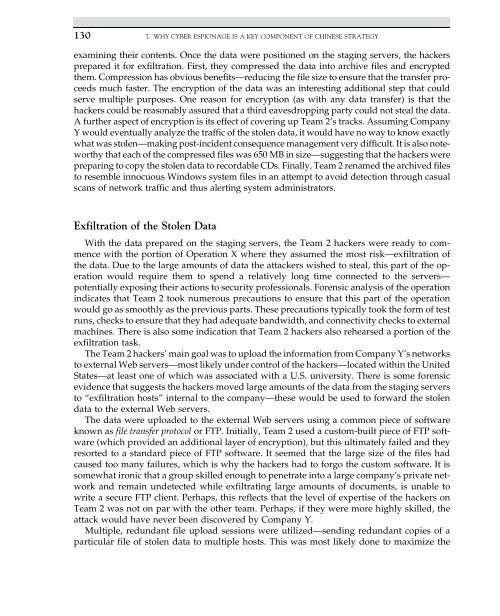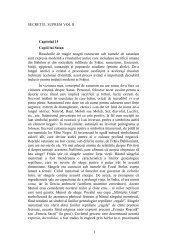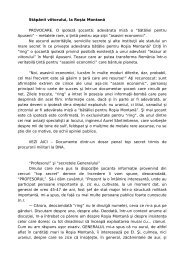Introduction to Cyber-Warfare - Proiect SEMPER FIDELIS
Introduction to Cyber-Warfare - Proiect SEMPER FIDELIS
Introduction to Cyber-Warfare - Proiect SEMPER FIDELIS
You also want an ePaper? Increase the reach of your titles
YUMPU automatically turns print PDFs into web optimized ePapers that Google loves.
130 7. WHY CYBER ESPIONAGE IS A KEY COMPONENT OF CHINESE STRATEGYexamining their contents. Once the data were positioned on the staging servers, the hackersprepared it for exfiltration. First, they compressed the data in<strong>to</strong> archive files and encryptedthem. Compression has obvious benefits—reducing the file size <strong>to</strong> ensure that the transfer proceedsmuch faster. The encryption of the data was an interesting additional step that couldserve multiple purposes. One reason for encryption (as with any data transfer) is that thehackers could be reasonably assured that a third eavesdropping party could not steal the data.A further aspect of encryption is its effect of covering up Team 2’s tracks. Assuming CompanyY would eventually analyze the traffic of the s<strong>to</strong>len data, it would have no way <strong>to</strong> know exactlywhat was s<strong>to</strong>len—making post-incident consequence management very difficult. It is also noteworthythat each of the compressed files was 650 MB in size—suggesting that the hackers werepreparing <strong>to</strong> copy the s<strong>to</strong>len data <strong>to</strong> recordable CDs. Finally, Team 2 renamed the archived files<strong>to</strong> resemble innocuous Windows system files in an attempt <strong>to</strong> avoid detection through casualscans of network traffic and thus alerting system administra<strong>to</strong>rs.Exfiltration of the S<strong>to</strong>len DataWith the data prepared on the staging servers, the Team 2 hackers were ready <strong>to</strong> commencewith the portion of Operation X where they assumed the most risk—exfiltration ofthe data. Due <strong>to</strong> the large amounts of data the attackers wished <strong>to</strong> steal, this part of the operationwould require them <strong>to</strong> spend a relatively long time connected <strong>to</strong> the servers—potentially exposing their actions <strong>to</strong> security professionals. Forensic analysis of the operationindicates that Team 2 <strong>to</strong>ok numerous precautions <strong>to</strong> ensure that this part of the operationwould go as smoothly as the previous parts. These precautions typically <strong>to</strong>ok the form of testruns, checks <strong>to</strong> ensure that they had adequate bandwidth, and connectivity checks <strong>to</strong> externalmachines. There is also some indication that Team 2 hackers also rehearsed a portion of theexfiltration task.The Team 2 hackers’ main goal was <strong>to</strong> upload the information from Company Y’s networks<strong>to</strong> external Web servers—most likely under control of the hackers—located within the UnitedStates—at least one of which was associated with a U.S. university. There is some forensicevidence that suggests the hackers moved large amounts of the data from the staging servers<strong>to</strong> “exfiltration hosts” internal <strong>to</strong> the company—these would be used <strong>to</strong> forward the s<strong>to</strong>lendata <strong>to</strong> the external Web servers.The data were uploaded <strong>to</strong> the external Web servers using a common piece of softwareknown as file transfer pro<strong>to</strong>col or FTP. Initially, Team 2 used a cus<strong>to</strong>m-built piece of FTP software(which provided an additional layer of encryption), but this ultimately failed and theyresorted <strong>to</strong> a standard piece of FTP software. It seemed that the large size of the files hadcaused <strong>to</strong>o many failures, which is why the hackers had <strong>to</strong> forgo the cus<strong>to</strong>m software. It issomewhat ironic that a group skilled enough <strong>to</strong> penetrate in<strong>to</strong> a large company’s private networkand remain undetected while exfiltrating large amounts of documents, is unable <strong>to</strong>write a secure FTP client. Perhaps, this reflects that the level of expertise of the hackers onTeam 2 was not on par with the other team. Perhaps, if they were more highly skilled, theattack would have never been discovered by Company Y.Multiple, redundant file upload sessions were utilized—sending redundant copies of aparticular file of s<strong>to</strong>len data <strong>to</strong> multiple hosts. This was most likely done <strong>to</strong> maximize the
















